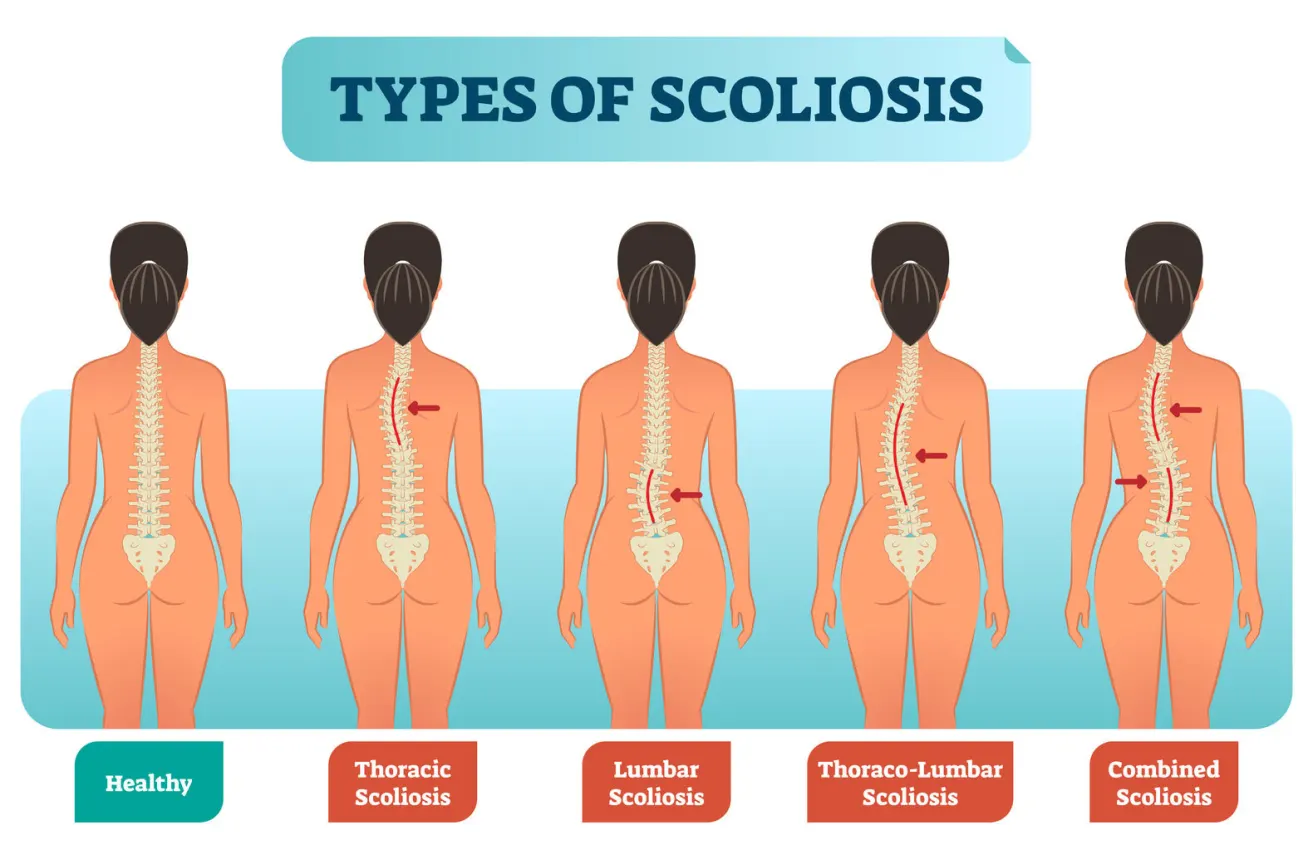What are the symptoms of scoliosis?
The symptoms of scoliosis can vary depending on the severity of the curvature and the age of the individual. Common symptoms include:
- Uneven shoulders: One shoulder may appear higher than the other.
- Prominent shoulder blade: One shoulder blade may stick out more than the other.
- Uneven waist: The waist may look asymmetrical.
- One hip higher than the other: The hips may be uneven, with one side higher than the other.
- Visible curve in the spine: The spine may have an abnormal curve that can be seen when standing straight.
- Clothes not fitting properly: Clothing may hang unevenly due to the asymmetry in the body.
- Back pain: In some cases, scoliosis can cause discomfort or pain in the back, particularly in adults.
- Fatigue: Muscle fatigue can occur due to the imbalance in the body’s alignment.
In more severe cases, scoliosis can also affect lung function due to the compression of the chest cavity, leading to breathing difficulties. These symptoms often prompt further medical evaluation and imaging, such as X-rays, to diagnose and assess the extent of the spinal curvature.
What are the causes of scoliosis?
Scoliosis can have various causes, which are often grouped into different categories:
- Idiopathic Scoliosis: The most common type, particularly in adolescents, has no known cause. It may be related to genetic factors, as scoliosis can run in families.
- Congenital Scoliosis: This form is present at birth and results from malformations of the spine during fetal development. Abnormalities in the vertebrae or ribs can lead to the development of scoliosis.
- Neuromuscular Scoliosis: This type occurs due to underlying neurological or muscular conditions such as cerebral palsy, muscular dystrophy, or spinal cord injuries. These conditions affect muscle control and balance, leading to the curvature of the spine.
- Degenerative Scoliosis: Usually occurs in adults and is caused by the degeneration of spinal discs and joints. This degeneration can result from aging, arthritis, or osteoporosis, leading to the curvature of the spine.
- Traumatic Scoliosis: This can develop after an injury to the spine, such as a fracture or surgery, which can disrupt the spine’s normal alignment.
- Syndromic Scoliosis: This type is associated with certain syndromes or conditions, such as Marfan syndrome, Ehlers-Danlos syndrome, or neurofibromatosis, which affect connective tissue or cause abnormalities in skeletal development.
In many cases, especially with idiopathic scoliosis, the exact cause is unknown, but a combination of genetic and environmental factors is believed to play a role.
How is the diagnosis of scoliosis made?
The diagnosis of scoliosis is typically made through a combination of physical examination, medical history, and imaging tests.
During the physical examination, the doctor will assess the spine’s curvature by observing the patient standing straight and bending forward. The Adam’s forward bend test is often used to identify any abnormal spinal curves. The doctor may also check for asymmetry in the shoulders, waist, or hips.
The patient’s medical history is reviewed to determine any family history of scoliosis, the onset of symptoms, and any related conditions.
Imaging tests are crucial for confirming the diagnosis and assessing the severity of the curvature. An X-ray of the spine is the most common imaging test used to measure the degree of the spinal curve. The Cobb angle is measured on the X-ray to determine the severity of the curve. In some cases, an MRI or CT scan may be performed to get a more detailed view of the spine, especially if there are concerns about underlying conditions or spinal cord abnormalities.
In addition to these methods, the doctor may also assess the patient’s posture, balance, and gait to understand how the curvature affects their movement and overall function.
What is the treatment for scoliosis?
The treatment for scoliosis depends on the severity of the spinal curve, the age of the patient, and whether the curve is likely to worsen. Treatment options typically include observation, bracing, and surgery.
For mild cases, observation is often recommended. Regular check-ups and X-rays monitor the curve to see if it worsens, especially in children and adolescents who are still growing. If the curve remains stable and does not cause significant issues, no further treatment may be necessary.
For moderate curves, particularly in growing children, bracing may be prescribed to prevent the curve from worsening. The brace does not correct the existing curve but can stop it from getting worse as the child grows. The type of brace and how long it must be worn depends on the severity of the curve and the child’s age. Bracing is generally recommended for curves between 25 and 40 degrees in children who have significant growth remaining.
In severe cases or if the curve is worsening, surgery may be necessary to correct or stabilize the curve. The most common surgical procedure for scoliosis is spinal fusion, where two or more of the vertebrae are permanently connected to prevent further curvature. Rods, screws, or other hardware may be used to hold the spine in a more typical alignment during the healing process. Surgery is typically recommended for curves greater than 40 to 50 degrees, particularly if they are causing pain, difficulty breathing, or other complications.
In addition to these treatments, physical therapy may be recommended to strengthen the muscles around the spine, improve posture, and enhance overall function. While physical therapy does not correct the curve, it can help manage symptoms and improve the quality of life.
For adults with scoliosis, treatment focuses more on relieving pain and improving function, as the spine is no longer growing. This may include pain management strategies, physical therapy, and in some cases, surgery if the curve is severe and causing significant problems.

Leave a Reply
You must be logged in to post a comment.